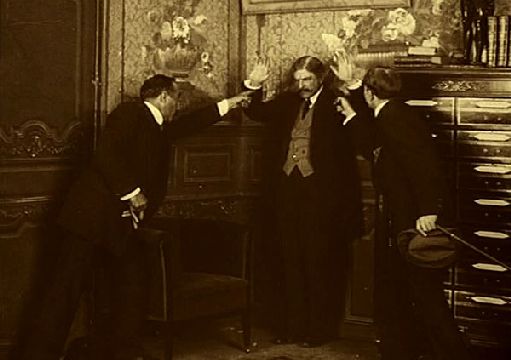Le mort qui tue (1913) 

Le mort qui tue (1913)
Director: Louis Feuillade
Cast: René Navarre, Edmund Breon, Georges Melchior
Synopsis: After a body disappears from inside the prison, a series of crimes take place, all seemingly by the dead man. With Juve presumed dead, Fandor must investigate alone. Will Fantomas finally be brought to justice?
With a running time of 90 minutes, Le mort qui tue, the third in Louis Feuillade’s five part serial about Fantômas, the villain of Pierre Souvestre and Marcel Allain’s phenomenally successful novels, is one of the longest episodes. Having been trapped in a building demolished by the dastardly Fantomas at the end of the second instalment, Inspector Juve (Edmund Breon – A Yank at Oxford, The Thing from Another World), Fantômas’s law enforcement nemesis, takes something of a back seat in this episode, appearing only occasionally while heavily disguised as a dim-witted assistant to a pawn shop owner who has a sideline as a fence for the criminal fraternity. Most of the leg work is left to Juve’s indefatigable sidekick, Fandor (Georges Melchior – Juve contre Fantômas), who seems to spend an inordinate amount of time scaling wrought iron gates as he investigates the mystery of an artist who disappears while in police custody after having been framed for murder.
What Fandor doesn’t know – but the audience does – is that the luckless artist was throttled by one of the prison warders in the employ of Fantômas (Ramon Navarre –Juve contre Fantômas) and his body spirited away (although how, exactly, is never explained) so that the master villain could make a glove containing the dead man’s fingerprint, thereby framing the dead man for the subsequent crimes Fantômas commits. It’s the kind of daffy, convoluted plot that is typical of this serial, and despites its silliness it still holds up remarkably well today. Fantômas is the kind of criminal mastermind that spends a lot of time hiding behind curtains, and has a habit of over-complicating his schemes. But he pulls them off somehow which, obviously, he has to for the series to continue. It’s good, old-fashioned fun, but it lacks the energy of the second instalment thanks mostly to being confined to interior shots.
(Reviewed 17th April 2015)

